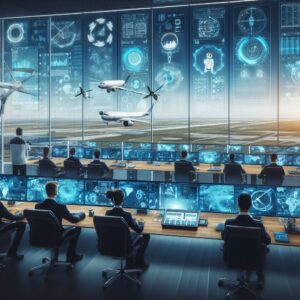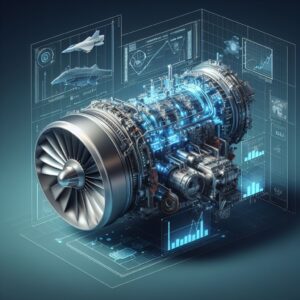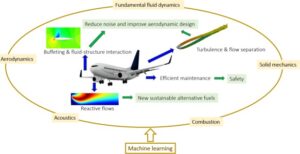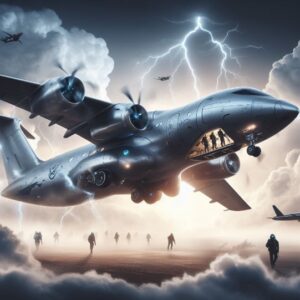
By Sambit Mishra and James Myers
Artificial Intelligence (AI) has made significant inroads into many industries, and one of the most promising and rapidly evolving sectors is aviation. With the potential to enhance safety, efficiency, and passenger experience, AI is changing the way we think about air travel. In this article, we will explore the key applications of AI in aviation and the future they represent to the industry.
AI in Aircraft Maintenance
Ensuring the safety and reliability of aircraft is of utmost importance in the aviation industry where AI plays a critical role. AI helps in predicting when maintenance is needed and improving the scheduling of maintenance tasks. Maintenance personnel use AI-powered systems to monitor the health of aircraft components, engines, and systems in real-time.
These predictive maintenance models can help airlines reduce costly unscheduled maintenance events and increase overall operational efficiency. In addition, AI-based robots are also being used by ground crews at major airports to assist with tasks such as cleaning the aircraft exterior to facilitate inspections of engines and other key components.
AI in Air Traffic Management

Air traffic management is another area where AI is revolutionizing the industry. AI-powered systems can optimize air traffic routes, reduce congestion, and improve safety. These systems can handle complex calculations and decision-making when aircraft are on the ground and in flight, enhancing the efficiency of air traffic control (ATC). Moreover, AI helps in predicting and mitigating delays caused by weather or other factors.
In March, 2023 Mälardalens University in Sweden came up with an AI-based solution to assist with ATC decisions. Using the AI, air traffic controllers will have greater ability to calculate, predict, and prevent delays and disruptions while tracking the ground positions of aircraft . Built on XAI (eXplainable Artificial Intelligence), the system uses machine learning to create 2D and 3D maps and analyze many possible ways to mitigate disruptions. It then chooses the best options, which it presents, together with an explanation, to the human controller.
AI in Aircraft Design
The design of aircraft has traditionally been a very costly, labor-intensive, and time-consuming process. AI, through generative design algorithms, has streamlined this process by exploring thousands of design possibilities in a fraction of the time a human engineer would require. This not only accelerates innovation, but also leads to more fuel-efficient and environmentally friendly aircraft.
 Every design that involves moving in fluids, like air, involves a trade-off between performance, on the one hand, and human safety and comfort on the other.
Every design that involves moving in fluids, like air, involves a trade-off between performance, on the one hand, and human safety and comfort on the other.
In a racing car, for example, the trade-off is between speed and road grip, and in aviation it is a question of making the aircraft accommodate as many people as possible or flying longer on less fuel.
Most airline manufacturers choose somewhere in between, with the help of AI to optimize both goals. By optimizing performance in the fluid dynamics of air, AI can reduce costs, enhance structural design, increase navigational efficiency, and provide simulations for other potential improvements.

Machine learning assists in analyzing fluid dynamics and aircraft design. Image: Science Direct
The ability of AI to perform complex calculations involving many interacting variables in seconds is definitely a big asset in designing aircraft that require incredible precision for human safety.
AI and the future of electric aircraft

Our look at advancements in electric propulsion technology within the aerospace industry will focus on two prominent companies, Rolls-Royce and Altair. Both have made significant strides in developing electric propulsion systems for aircraft, with different approaches and innovations that have the potential to bring electric propulsion into the future of aviation.
Electric propulsion has garnered significant attention as a sustainable and efficient alternative for aviation.
With mounting concerns about environmental damage and energy efficiency of aviation, companies like Rolls-Royce and Altair have embarked on groundbreaking projects to develop and implement electric propulsion systems in aircraft.
Rolls-Royce’s “ACCEL” Project
Rolls-Royce, a renowned name in aviation, initiated the Accelerating its Electrification of Flight (ACCEL) project with the aim of creating the world’s fastest all-electric aircraft.
Key components of the project include:
- Aircraft design: Rolls-Royce developed the “Spirit of Innovation,” an electric plane featuring three high-power-density electric motors.
- Battery innovation: The company partnered with Electroflight and YASA, an electric motor manufacturer, to create an advanced battery pack with a power density equivalent to around 250 Wh/kg.
- Sustainability focus: The project reflects a commitment to sustainability, aiming to demonstrate the potential of electric propulsion to reduce aviation’s environmental impact.
Altair’s “eVTOL” Initiatives
Altair, a leading technology company, ventured into the electric vertical takeoff and landing (eVTOL) sector. Their initiatives include:
- eVTOL prototypes: Altair introduced innovative eVTOL aircraft prototypes that showcase their agility of electric propulsion systems and their potential for urban air mobility.
- Multidisciplinary approach: Altair emphasized the use of simulation and optimization software to develop electric propulsion systems to maximize performance and efficiency.
- Urban Air Mobility (UAM): Altair’s eVTOL initiatives align with the growing interest in UAM, offering a glimpse into a future where electric propulsion plays a crucial role in urban transportation.
Altair isn’t stopping at eVTOL. Altair leverages its expertise in simulation, high-performance computing (HPC), and AI to help organizations navigate this evolving landscape with advanced design and simulation infrastructure. NASA is an Altair client and, as quoted by Altair, “NASA-JPL engineers adopt Altair® EEvision™ electronic system visualization software to help develop their Europa, Psyche, and Mars Sample Return interplanetary space missions.”
Which electric propulsion method will come to market first?
In terms of both technology and innovation, both Rolls-Royce and Altair demonstrate innovation in electric propulsion technology. While Rolls-Royce focuses on high-speed aircraft, Altair concentrates on smaller urban mobility vehicles, showcasing the versatility of electric propulsion.
For sustainability, both companies prioritize environmental sustainability, with Rolls-Royce emphasizing emissions reduction in long-haul flights and Altair addressing the need for eco-friendly urban transportation.
Both Rolls-Royce and Altair exemplify the transformative potential of electric propulsion in the aerospace industry by actively pushing the boundaries of electric propulsion technology. By developing sustainable and efficient electric propulsion systems, these companies aim to revolutionize the way we think about aviation and urban transportation, paving the way for a cleaner and more sustainable future in aerospace.
AI in Passenger Experience
AI enhances passenger experience in various ways, from personalized in-flight services to streamlined airport procedures. Chatbots and virtual assistants can provide passengers with information, check them in, and help them navigate the airport. AI algorithms can optimize flight schedules to reduce passenger waiting times, making travel more convenient.
 According to Ioanna Papadopoulou, Director, Communications & Marketing at Athens International Airport, increased automation in the post-Covid pandemic era will benefit passengers who are looking for a contactless, seamless, and easy processes like airport check-ins to decrease time and stress levels. Athens International Airport has introduced an AI, made by PathosAI, to provide feedback on passenger “emotional engagement metrics” with contact points such as e-mails, website queries and complaints, and chatbots.
According to Ioanna Papadopoulou, Director, Communications & Marketing at Athens International Airport, increased automation in the post-Covid pandemic era will benefit passengers who are looking for a contactless, seamless, and easy processes like airport check-ins to decrease time and stress levels. Athens International Airport has introduced an AI, made by PathosAI, to provide feedback on passenger “emotional engagement metrics” with contact points such as e-mails, website queries and complaints, and chatbots.
The aim is to “identify what really matters to passengers, determining the actions/new services/products needed to contribute to the restoration of confidence, by alleviating stress and anxiety levels, delivering a memorable passenger experience, and meeting the ‘new era’ passengers’ needs and wants.” The AI analyzes passengers parameters such as speech and tone, with the aim of optimizing and personalizing interactions. While the accuracy of such AIs might be questionable, and the technology can give rise to ethical issues with privacy and consent, it represents a trend in customer service among many industries.
AI in Security.
Passenger safety is paramount in aviation, and AI is a major tool in this respect. The security failures that led to the tragic events in the U.S. on September 11, 2001 have accelerated AI-driven airport security systems to help maintain significantly enhanced restrictions to what passengers can do and carry.
AI systems are being used to detect threats by scanning for as unusual objects at airports, in baggage, and on passengers. Many passengers are now becoming familiar with biometric scanners that use facial recognition at check-in kiosks, security gates, and border control, although there are continuing ethical concerns about possible misuse and misidentifications. Security scanners previously capable of identifying only metal objects on passengers have been upgraded to full-body scanners, and algorithms alert security personnel to higher-risk situations that may require personal inspection.
Conclusion
Artificial Intelligence is transforming the aviation industry by enhancing safety, optimizing operations, and improving the passenger experience. With continuous advancements in AI technology and increasing industry adoption, we can expect to see even more remarkable changes in the way we fly. The potential for greater efficiency, safety, and innovation in aviation is boundless, making AI a key player in shaping the future of air travel.
As the aviation industry embraces AI, it is essential for stakeholders to stay updated on the latest developments and innovations, ensuring that aviation remains a safe, efficient, and enjoyable mode of travel for all.



